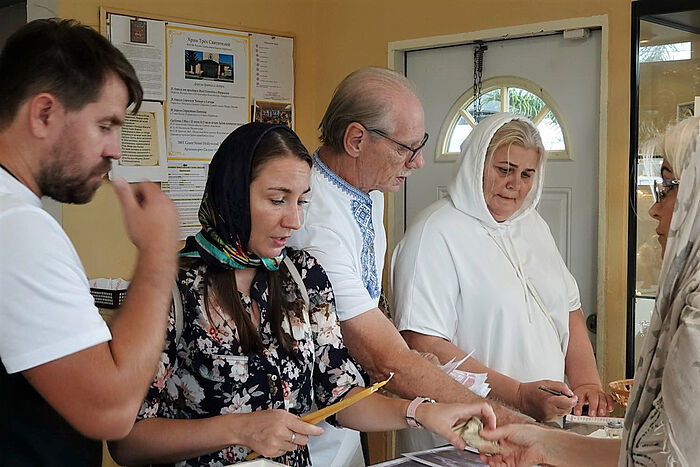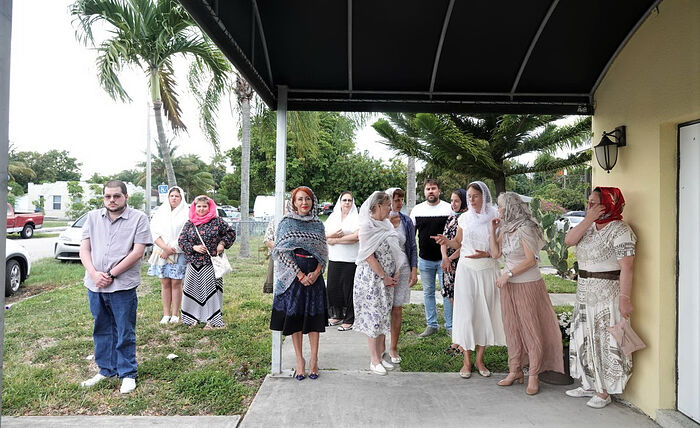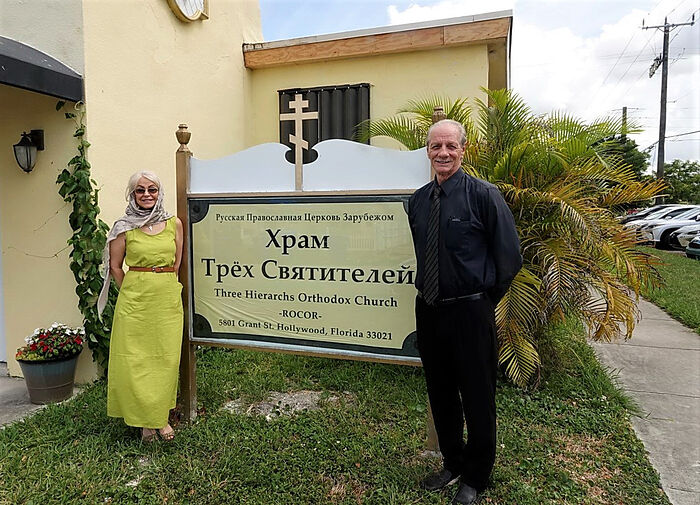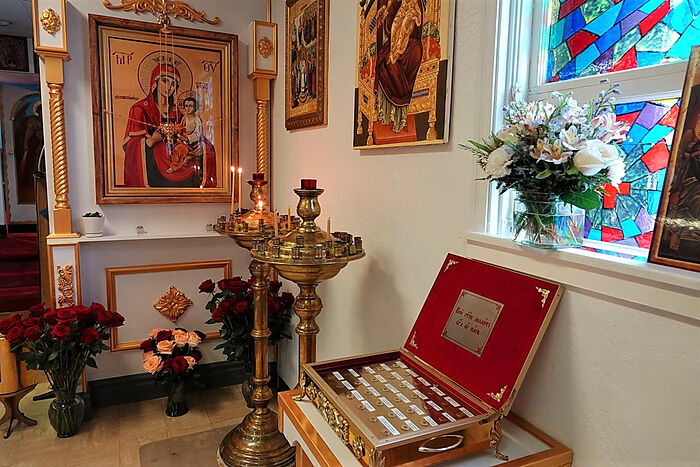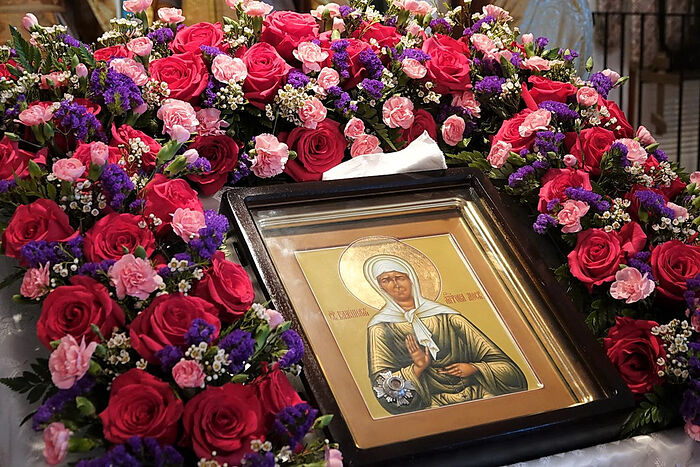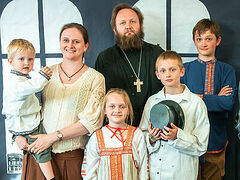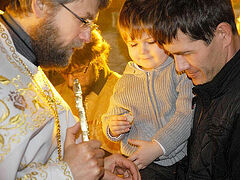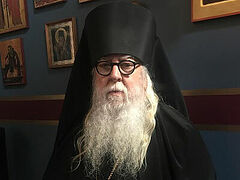The journey to America of Blessed Matrona of Moscow, one of the Russians’ most beloved saints, began at the end of February, when, with the blessing of His Holiness Patriarch Kirill, Mother Theophania, the abbess of Holy Protection Monastery in Moscow gave an icon with a piece of the relics of the blessed Eldress Matrona to the faithful of the Eastern American Diocese of the Russian Church Abroad. The icon was delivered to New York by the rector of Holy Protection Church in Glen Cove, the dean of New York City and the state of Florida, Archpriest Alexander Anchutin. The relics would later be delivered to Florida.
The people pray to Matronushka, as they call her, in sicknesses and many everyday troubles. The power of this saint’s help is amazing. Perhaps that’s why the flow of people to her relics at Holy Protection Convent in Moscow never stops. There are also many believers in Florida from Moscow, St. Petersburg, and other places of the former Soviet Union—immigrants and tourists, who revere St. Matrona and want to venerate her relics.
Pascha passed, and on the bright feast of the Ascension of the Lord, when the festive Liturgy was served, Fr. Alexander arrived with the relics at LaGuardia Airport in New York, overflowing with people eager to travel after the pandemic.
It was announced that there was a thunderstorm on its way to Florida. The plane took off only an hour and a half later and arrived at Ft. Lauderdale when the sun had already set. The next day, the feast of St. Luke of Crimea, the relics were to be transported to the place of their permanent residence—Three Holy Hierarchs Church in Hollywood, Florida.
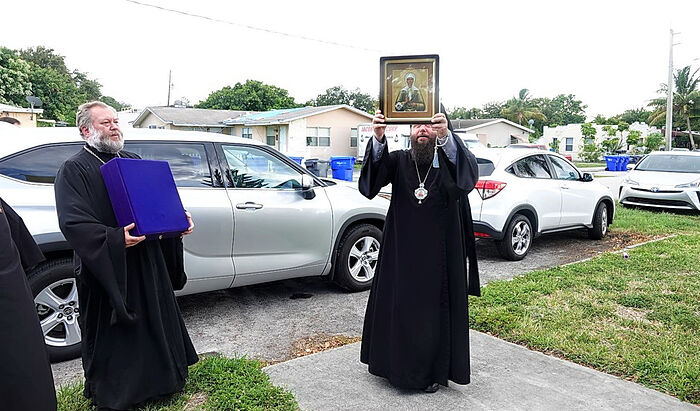 Greeting the icon of St. Matrona
Greeting the icon of St. Matrona
That morning, the phone was ringing nonstop for the local priest Archimandrite Silouan (Lembey), who came to Florida from Ukraine, with faithful calling and asking when the icon would be there and how long it would be in the church. Father assured them: The icon was coming to its permanent home. Closer to evening, numerous believers, not just from Miami and the suburbs, but also from more remote places, gathered at Three Holy Hierarchs Church to greet and prayerfully welcome to the saint.
Taking the icon of Matronushka from Fr. Alexander, Bishop Nicholas of Manhattan, the vicar of the Eastern American Diocese and rector of Three Holy Hierarchs Church, blessed the church, the surrounding area, and the congregation.
The inscription on the back of the icon reads:
With the blessing of His Holiness Patriarch Kirill of Moscow and All Russia, this icon of Blessed Matrona of Moscow with a particle of her holy relics is given to the Florida Deanery of the Eastern American Diocese of the Russian Church Abroad. 2021.
Vladyka entered the church, again blessed the faithful, and placed the icon on an analogion, where it remained through the end of Matins, when His Grace anointed the parishioners with blessed oil from the relics of St. Matronushka, and during the Liturgy the next morning.
A church of three jurisdictions
Since its founding in 1962, the church was in the jurisdiction of the Orthodox Church in America. The founders—immigrants to America from Eastern Europe—gathered money and purchased a building from some Protestants, where they built an Orthodox church. They also bought two neighboring buildings and a territory with palm trees in the background with the long-term aim that should there ever be a lack of funds, the future parishioners would have money for the upkeep of the church.
When the leadership of the OCA called for the church to switch to the new calendar, the parish council decided to remain on the old calendar and go under the omophorion of the Carpatho-Russian Church of the Patriarchate of Constantinople.
The parish lived prayerfully, actively, and joyfully. They served in Church Slavonic. Russians, Ukrainians, Slovaks, and immigrants from other Eastern European countries organized national festivals, so popular in the New World where every other person is an immigrant. In hats and Ukrainian wreaths, traditional headdresses, and embroidered shirts—some of the photos have survived till today in the parish archives, though the majority were ruined recently by the leaking ceiling (due to the powerful and destructive tropical downpours). The parish still remembers a relative of the famous composer Sergei Rachmaninoff—Elaine Rachmaninoff-Murina. Named Elena in Baptism, she went to the church as long as there were services. Now she’s eighty-six.
The local newspaper wrote about the events in the parish. One of the articles talked about the 48th anniversary of the priestly ordination of the church’s first priest—Archpriest Vladimir Lilikovic. The parishioners prepared a surprise party for Batiushka and Matushka. First they were greeted by the choir, directed by the parish’s Walter Kessel, and then they brought out a nearly 6.5-foot-long cake, made by Millie Shuk, the elder sister of the parish sisterhood. The huge cake consisted of eleven separate cakes, connected and decorated with several pounds of icing.
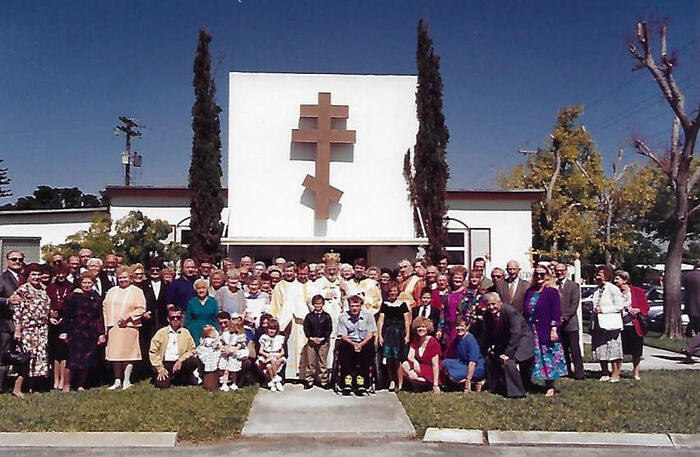 Three Holy Hierarchs Church, 1960s
Three Holy Hierarchs Church, 1960s
Fr. Vladimir was ordained in 1917 at St. Nicholas Cathedral, now of the Moscow Patriarchal parishes in America. In 1961, when he was serving in Michigan, the community being created in Florida invited him to organize the parish of the Three Holy Hierarchs Church. The mitred archpriest reposed there twenty years later on October 16, 1981.
Around that time, the children of the first parishioners had assimilated and no longer understood the services, so it was decided to celebrate part of the services in English, eventually moving entirely to English. But it was too late. They invited newly-arriving Russian-speakers, but they wanted “Russian services.” The number of parishioners shrunk and shrunk, and the church fell into disrepair.
But not all the children left. Elena Rachmaninoff’s son not only didn’t leave the church, but even became a priest, and today Fr. Philip Reese is the honorary rector of Christ the Savior Cathedral in Miami, which was founded in 1962, like Three Holy Hierarchs Church, to whose history we return again.
At some point, the Carpatho Diocese expressed the intention of selling the church building, but here the first parishioners had also covered themselves: They wrote in the parish charter that the church is not subject to sale as long as at least one or two parishioners are going to church and the parish pays its diocesan dues.
Kerry and Larisa
The only ones who were still going to church regularly were Kerry (Seraphim in Baptism) and the current church warden Larisa Johnson-Gorchakova. He’s an American and she’s from the Ryazan Province in Russia.
“We’ve seen many parishioners and many priests; we’ve seen a church full of people praying, and, alas, we’ve seen it completely empty,” says Larisa. “In 2014, many Ukrainians came to the church. Wonderful people! But after the Maidan revolution, they all left at once and became aggressive towards us. There was practically no one left at church then.”
Larisa was born in the district center of Sasovo in the Ryazan Province. Her father, a Muscovite, never knew that she was baptized. Then she lived and worked for many years in the city of Ukhta in the Komi Republic. There was no church there then.
“By the time I met Kerry, I already had an adult son. This was during the Chechen war,” Larisa continues. “I had many friends who lost children in Chechnya. My Alexei was finishing college. I remember the graduates were given a diploma with a summons to the military enlistment office, and I decided to get my son out of there. Maybe it’s not patriotic, but every mother tries to save her child. It was an incomprehensible war, so many tried to disown Chechnya then, and the army too. So we came to America.”
“In Florida, Kerry and I started looking for an Orthodox church in the phone book, and we found Three Holy Hierarchs. Kerry was baptized here. We got married here. Kerry became the treasurer and would go to church even when there was only reader services. He regularly paid the dues to the diocese and actually saved the church from being sold.”
Although Larisa’s entire American life was spent in this church, it didn’t start out easy:
“I consciously came to Orthodoxy through a serious yoga class,” Larisa recalls. “I even thought about going to India. I completely withdrew from worldly life; nothing interested me. All I did was work and meditate. At the same time, I kept going to church with my husband this whole time, but I didn’t grasp very much in the services, since they were in English. I also couldn’t commune, since I was a yogini!”
It was the events in Ukraine that brought her back to a healthy Christian life.
“At that time, my mother came to visit. Like before, I was either working or sitting and meditating. My mama said, ‘Look at what’s happening in Ukraine.’ I came out of the bedroom and saw the Maidan on TV. And at that moment, I switched back to reality, and since then I’ve been delving into the surrounding events. I didn’t go to India—I realized that yoga doesn’t set any goals for you, unlike Orthodoxy, which offers us the opportunity and means on the path to salvation.
We begged for a priest
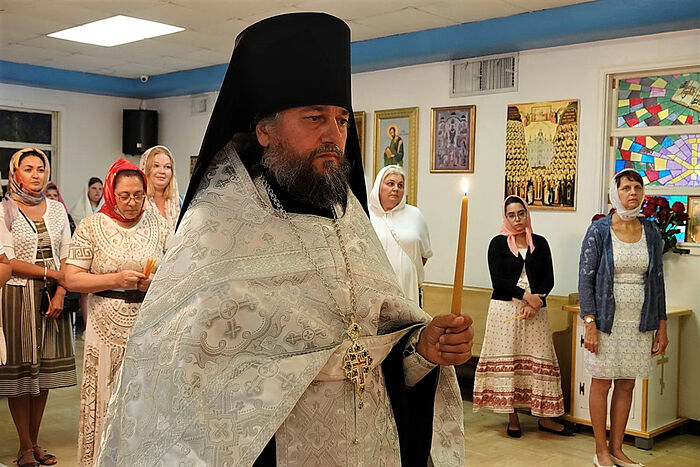 Archimandrite Silouan (Lembey)
Archimandrite Silouan (Lembey)
For four years, the parish rented the building to the Ethiopians, so there continued to be prayers here. The Ethiopians wanted to buy the church building, but the parish appealed to the hierarchs of the Russian Church Abroad to take us under their omophorion. And then a few of the parishioners heard about Fr. Silouan—a monk serving in a mission in Orlando—and asked for him to be appointed to our church.
The church roof was leaking then. The attic had an iguana living in it. The creature grew and used to look down into the church while the services were being held.
That’s how the church was when Fr. Silouan saw it. He was tonsured twenty-six years ago at Holy Dormition Monastery in the Volyn Province in Ukraine, and when friends asked what to give him for his twenty-fifth anniversary, Fr. Silouan asked for a reliquary with particles of saints’ relics for Three Holy Hierarchs Church, where he had been assigned the previous year on the feast of the Dormition of the Most Holy Theotokos. Since then, the church has been open daily with Divine services and akathists being celebrated. Fr. Silouan doesn’t only serve—he also builds. The long-suffering ceiling has already been replaced, a new trapeza has been finished, a new kitchen has been installed, and the church has been decorated with painted icons.
“He has a golden heart and golden hands,” the parishioners say about their priest. And the warden adds that the church was lucky too:
“Our church has financial support, which the first parishioners saw to, which many small churches in America can only dream of. There’s a huge territory around the church where we’re planning to hold cultural events. And in order for parishioners of all nationalities to finally live together amicably, we have to develop a true community, as it was from the beginning of the foundation of our church. And at every service, Fr. Silouan audibly prays for the welfare of the Churches of the countries that our parishioners came from.”
This is where the icon of St. Matrona came to from Moscow, through New York. And now Blessed Matrona remains here with her holy relics, strengthening and edifying the parishioners, helping the parish grow and once again become the house of God that it was in its best years.

